So you or someone you know is pregnant, and wants to keep tramping?
Firstly, congratulations!!
Secondly, yes, outdoor adventures are 100% doable for many pregnant people. They may look slightly different to your normal trips, but you shouldn’t have to give them up entirely if you don’t want to.
I wish more people had told me that, rather than giving me the well-meaning (but very discouraging) advice that I’d need to “slow down” and “take it easy”. Obviously some people do, but a lot don’t need to!
The American College of Obstetricians and Gynaecologists recommend “In the absence of obstetric or medical complications or contraindications, physical activity in pregnancy is safe and desirable, and pregnant women should be encouraged to continue or to initiate safe physical activities”. Pregnancy isn’t normally an illness that you need to rest and recover from. Staying fit and active in pregnancy is a great way to prepare your body and mind for birth and beyond.
Disclaimer: this article is based on personal experience with my own pregnancy, which was low-risk in first and second trimesters. I am not a midwife or an obstetrician. Every pregnancy is different, so if in doubt you should seek and follow advice from your lead maternity carer (LMC). This article is also written on the premise that you already have experience with tramping and want to continue to get outdoors. Pregnancy probably isn’t the time to start a new adventure hobby!
Also if you don’t want to keep tramping, that’s cool too. You’ve got to do what’s right for you, your body and your mind, no judgement! Pregnancy can be hard – don’t feel bad if your priorities change.
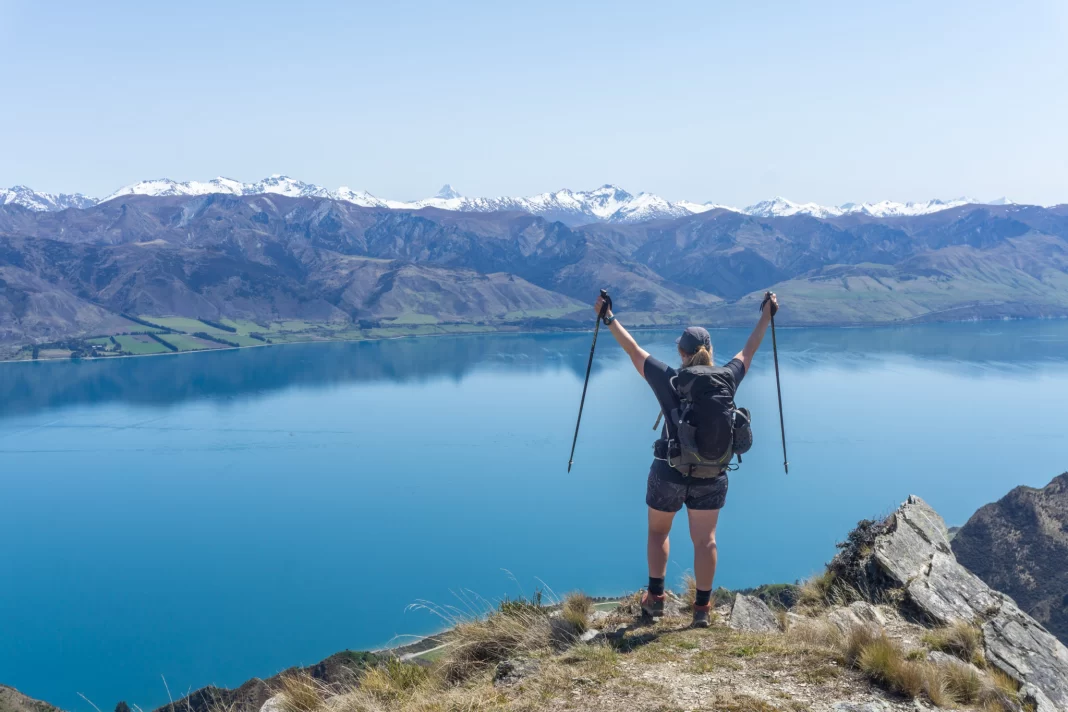
Table of Contents
A little bit about me
First trimester (0 – 12 weeks)
Dealing with nausea, constipation, fatigue and pregnancy loss/complications
Second trimester (13 – 27 weeks)
Information on nutrition, hydration, pelvic floor, joint changes and target heart rates
Third trimester (28 weeks – birth)
What to expect in terms of lung capacity, changing clothing and footwear requirements, centre of balance, core muscles, dealing with heat, and access to healthcare.
Final thoughts on tramping while pregnant
A little bit about me
I’m writing this during my third trimester with my first child. My body already feels like it’s been on a roller coaster for the past 8 months, and I haven’t even given birth yet. BUT I’ve managed for the most part to stay as active as I wanted, which has been truly empowering during pregnancy.
You’ll probably already have realised from this blog that I enjoy tramping (hiking) a LOT. My husband and I found out that we were pregnant in May 2022 (autumn for the southern hemisphere). I went skiing, snowshoeing and travelled internationally during first and second trimester. This spring/summer I’ve been continuing to go tramping during my second trimester, and smaller walks during my third trimester. I’ve luckily had minimal complications until third trimester during this pregnancy, which has enabled me to stay active for most of it.
I found it helpful hearing others’ stories so that I could set realistic expectations for myself and tramping when pregnant. I also talked with my midwife and a pelvic floor / women’s health physiotherapist, as well as many colleagues at the hospital I work at, to help better inform myself around the risks and benefits.
I’d like to share my experiences in the hope that this will help you, if you want to keep going on epic tramping adventures while you’re pregnant! Keep in mind that every pregnancy is different.
The absolute best advice I have for you is to listen to your body. Just because your friend could keep going on epic adventures well into their pregnancy, doesn’t mean that you will be able to (or want to). Give yourself grace during this crazy time!
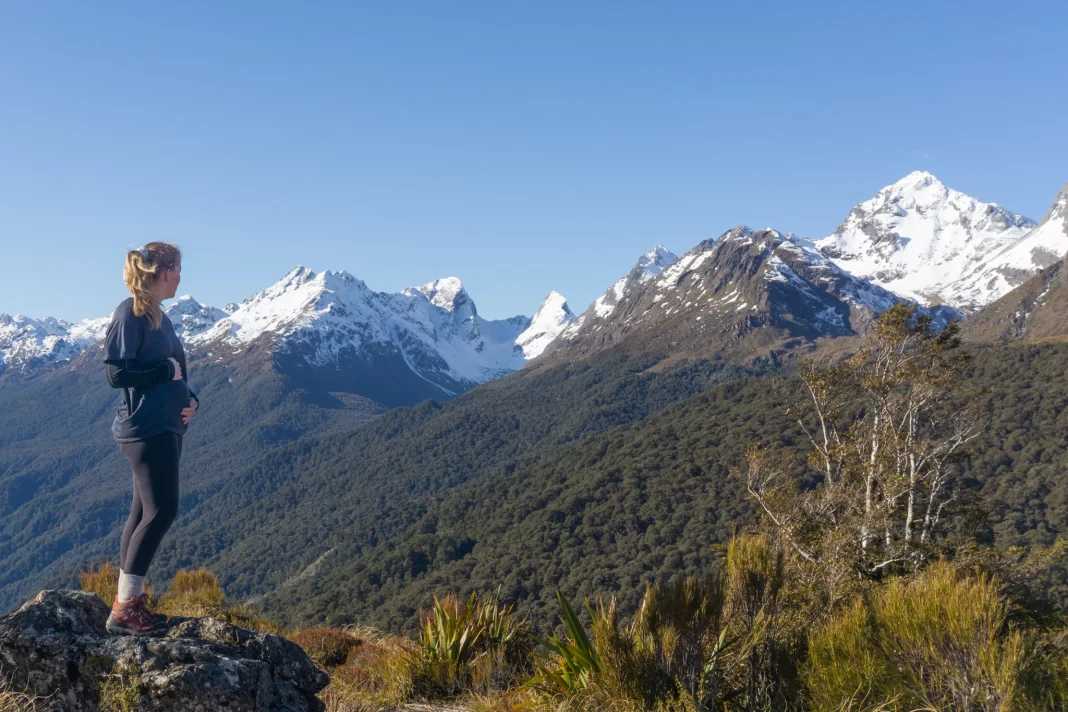
Tramping while pregnant: first trimester
0 – 12 weeks pregnant (first 3 months)
First trimester is a bit of a beast for most people. Symptoms can start almost immediately after conception (sore breasts, fatigue), but for a lot of people the nausea/fatigue really starts from Week 6 or 7 onwards. I hibernated for a lot of first trimester and didn’t get out tramping much.
Staying active during this period can be draining for lots of reasons. For me it wasn’t really possible once the symptoms started. Many people also choose not to tell people that they are pregnant until after 13 weeks due to the risk of pregnancy loss (more below), which can make tramping with friends and family difficult if you’re trying to hide your symptoms.
Here are some things that impacted tramping for me in first trimester:
Nausea / Constipation
Morning sickness is an incredibly misleading name. Nausea and vomiting during pregnancy is not just something that happens in the mornings – it can happen throughout the day. I very luckily avoided any ‘morning sickness’, but I had sought some anti-nausea medication from my GP that was safe to take in pregnancy, just in case. Vomiting can lead to dehydration and low energy, which can obviously impact your hiking, so it would be helpful to have something to take if this affects you (and have it ready before you need it if you’re still planning adventures).
I did however experience a lot of constipation, which is a common pregnancy symptom but less talked about than nausea (and more common in third trimester to be fair). This gave me an upset stomach, sapped my energy, and I ended up losing a couple of kgs. It would have made overnight tramping and eating dehydrated meals a bit of a nightmare. But thanks to the fatigue, overnight trips weren’t even on my radar.
Fatigue
Fatigue is another very common symptom of pregnancy, particularly in first trimester. From about 8-13 weeks, I would come home from work and collapse onto the couch, exhausted. Weekends were for resting and recovering, before the whole cycle started again on Monday. This wasn’t helped by catching COVID and dealing with that fatigue as well.
Feeling exhausted was the main thing that stopped me from tramping as much in first trimester, although I did fit in some short walks before Week 8. It also meant I went into second trimester feeling a bit deconditioned and less fit than I would have liked. But there wasn’t much that could be done about that other than listen to my body, and rest.
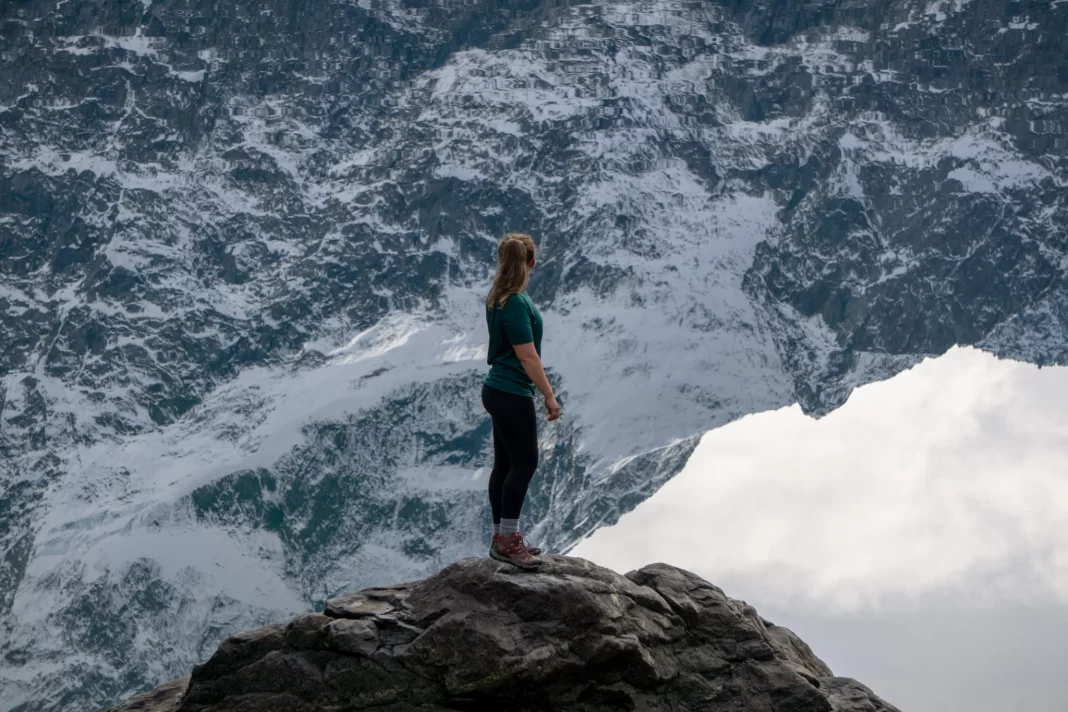
Pregnancy loss & complications
The reason that many people don’t announce their pregnancy publicly is that the risk of pregnancy loss / miscarriage is highest in first trimester, particularly before Week 8. Pregnancy loss was something that was on my mind when getting out and about during my first trimester. My first pregnancy had ended with a miscarriage at Week 7 while I was tramping the Routeburn Track. It was scary being in the outdoors when this happened. I’ve written about that experience here. Because of my miscarriage, during this second pregnancy I didn’t want to be too far away from medical services until an early scan at Week 7 had reassured me that my pregnancy was progressing normally.
There are also some conditions during first trimester (such ectopic pregnancies) that can be extremely serious and need medical intervention. If you have any pelvic pain, vaginal bleeding, shoulder pain, lightheadedness or fainting, then contact your midwife or see your doctor immediately.
The good news is that the American College of Obstetricians and Gynaecologists have released a report stating that there is no evidence that links exercise to miscarriage, wooh! (Although high impact sports or exercising at high elevations do present some increased risks to your pregnancy). So don’t feel guilty about exercising if you are able to and want to.
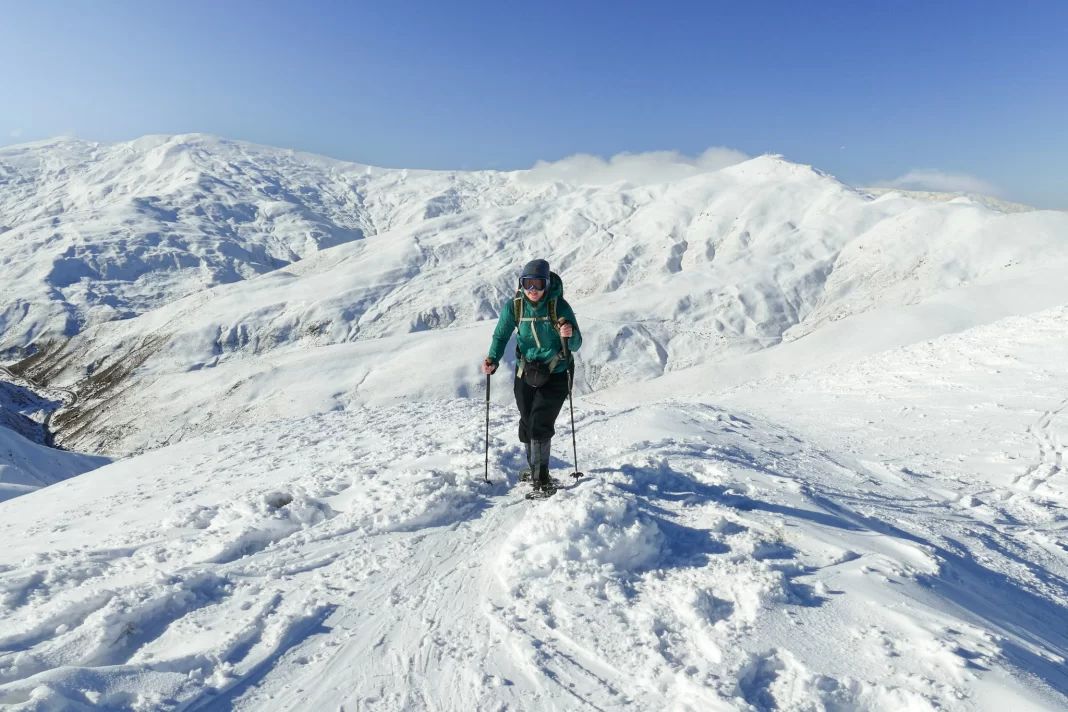
First trimester – summary
For many people, tramping will be scaled back in first trimester as they deal with early pregnancy symptoms. You might be able to still do crazy trips, you might not – time will tell! You won’t know how your body will deal with being pregnant until it’s happening, so don’t plan anything too ambitious over these first few months and let yourself take it easy if you need to.
Tramping while pregnant: second trimester
13 – 27 weeks (second three months)
If first trimester sounds a bit depressing, don’t fear – second trimester is here! Most people (but not all) experience a new burst of energy with their early pregnancy symptoms lessening, starting from between 13-18 weeks. Second trimester is when you can likely plan for more tramping trips, although you may need to make some of the below accomodations as your body continues to change.
I’m really happy with how my body allowed me to stay active and get out tramping during second trimester. My normal strategy of being ridiculously unfit at the start of summer, going on tramping trips and puffing my way to some semblance of fitness by the end of autumn, wasn’t really going to cut it this year. So I made an effort to start small as soon as I felt less fatigued (Week 14 for me), and then build up slowly, but surely.
Here are some changes I’ve had to make to my tramping trips during second trimester:
Nutrition
You might hear that you’re “eating for two” while pregnant. Which, while technically true, is extremely misleading. The general consensus is that you don’t need any extra calories in first trimester, only 300-350 calories extra per day in second trimester, and an extra 450 calories per day in third trimester. That doesn’t actually translate into much actual food.
I found that when tramping while pregnant however, I definitely felt like I needed to eat more frequently to keep my energy levels up. It was helpful to eat a small handful of nuts, fruit leather or chocolate (of course) every half hour or so, as otherwise I was more likely to ‘crash’. I started having GUs which I found helpful. And I definitely enjoyed large dinners and desserts at the hut in the evenings!

Hydration
On top of this I drank a LOT more water than I normally would – over three litres on some big days. I would try and hydrate the night before and morning of a tramp, so I wasn’t going into a tramp already dehydrated. Then I carried a bladder as well as a filter drink bottle, which I would refill when coming across streams etc.
Normally I just drink straight from most fast moving streams in the backcountry (unless I know there is a lot of animals or human activity in the area) and from DOC hut water tanks. However being pregnant I was more conscious of waterborne illnesses, like giardia. I boiled all hut water for at least a few minutes and left it to cool overnight to fill my drinking bladder, and then used my filter water bottle for the rest. It meant one less thing to stress about, but everyone will have different levels of risk they’re comfortable with.
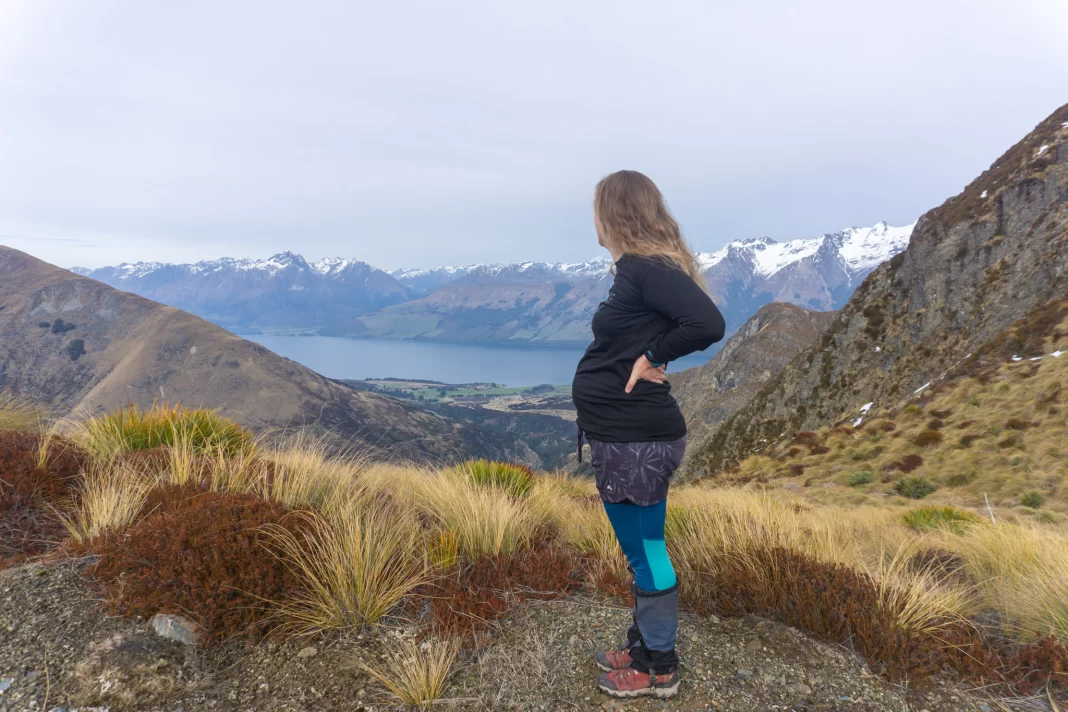
Pelvic floor & joints
The growing baby puts a lot of pressure on your pelvic floor muscles. On top of this, the hormones relaxin and progesterone start loosening your ligaments and joints in preparation for birth. Due to this, some people can experience urinary incontinence and/or pelvic and back pain. If you do experience any of these issues, seeing a women’s health physiotherapist is extremely helpful at managing or preventing these symptoms.
It’s a good idea to start limiting your pack weight as the pregnancy progresses – since this extra weight puts additional pressure on your pelvic floor and joints. My husband Matt started carrying more weight for me which was amazing, and I tried to keep my pack under 12kg on most of our trips. You may also be more prone to strains and other soft tissue injuries. I found using poles was helpful to give myself extra stability, as well as taking some of the pressure off my joints.
Lastly, be prepared to take more pee breaks. You’ll be drinking more, and your bladder is steadily shrinking in size to make room for your little one to keep growing.
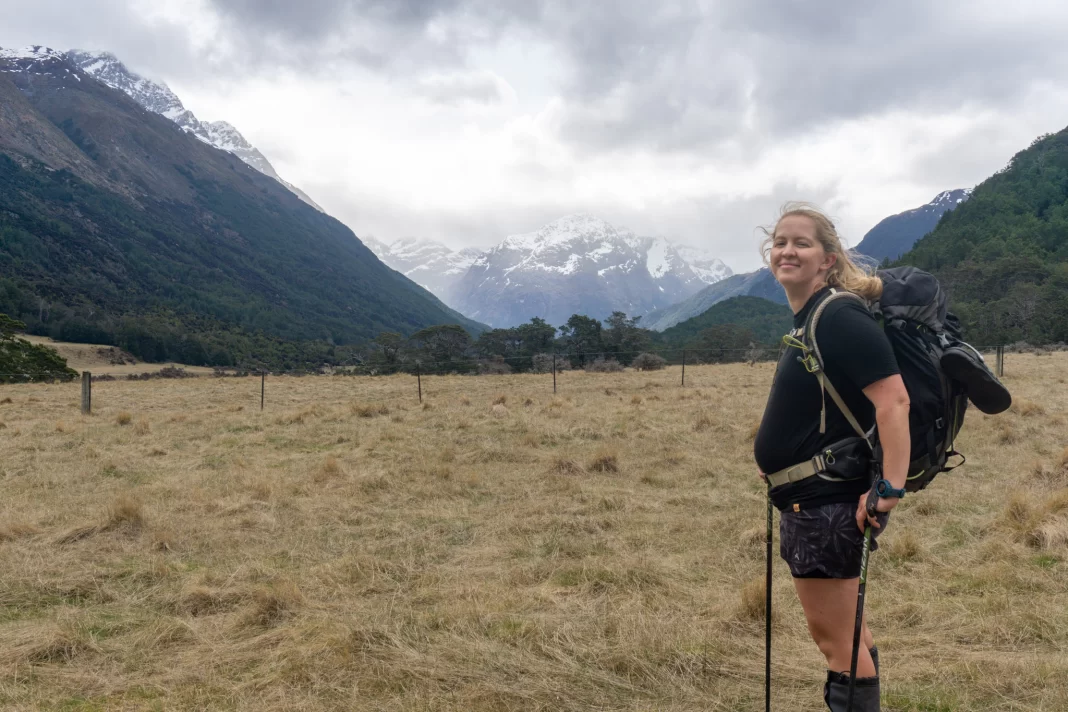
Heart rate
The old advice was that a pregnant person’s heart rate during exercise shouldn’t exceed 140 BPM (beats per minute). This is no longer currently recommended, since it’s not a specific measure of effort for different individuals (although many personal trainers may still abide by it). But rather when tramping while pregnant you should aim for moderate exercise. This means keeping your breathing under control so that you can still hold a conversation.
For me, this meant going a lot slower than I was used to – both when walking, but also taking very frequent, short standing breaks. I also took more sit-down breaks to rest, get off my feet and let my breathing return to normal. This was also when I could rehydrate and stock up on snacks.
Be aware of not overheating – a raised body temperature is a risk factor for birth defects, which is why it’s not recommended that pregnant people soak in spas or saunas. So take it easy, take rests, and plan around the weather. I noticed I was much more prone to sun stroke, even on a relatively overcast and not too hot day. In summer it would be a good idea to start really early before the day’s heat really builds.
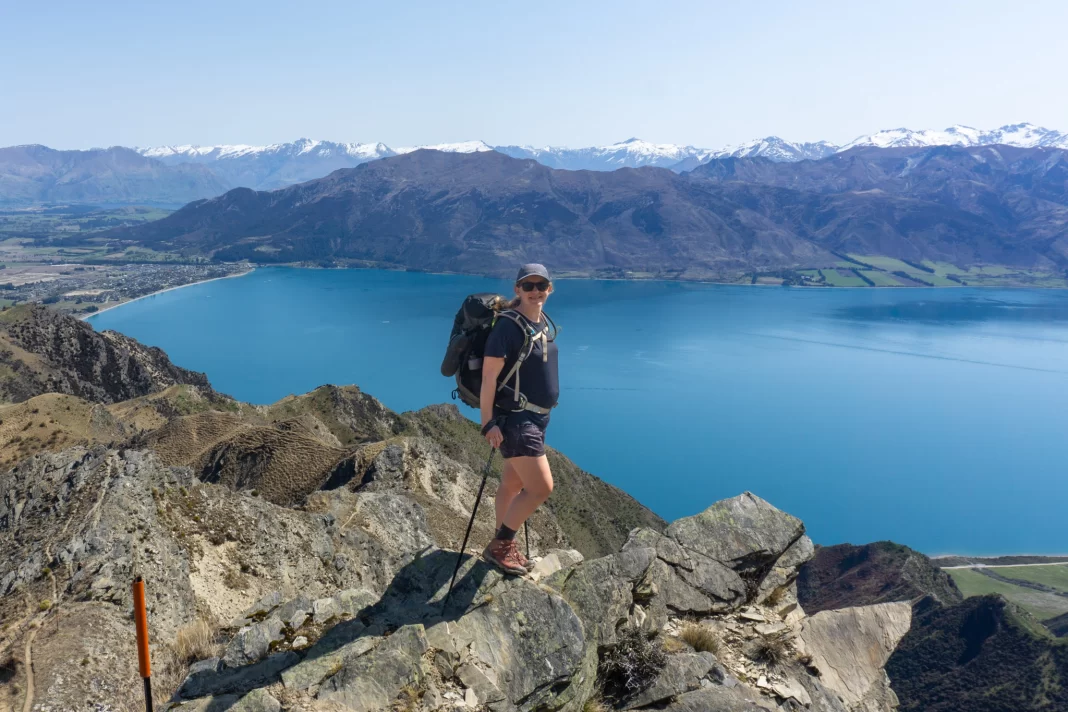
Second trimester – summary
While some adaptions will likely be necessary and every pregnancy is different, second trimester is when most people can plan to do normal tramping trips that they’d go on while not pregnant (within reason). However keep in mind that some pregnant people find that their early pregnancy symptoms continue for a lot longer than average, or that pelvic pain really limits their ability to exercise. Listen to your body (and your midwife / LMC), and make changes as you need to.
Tramping while pregnant: third trimester
28 weeks – birth (last three months)
Third trimester is when (for most people) you’ll need to start slowing down and really adapt your tramping. I’m only a few weeks away from birth and have definitely limited my walking as I became steadily less comfortable (varicose veins in your groin is not a fun time, 0/10 would not recommend). We haven’t managed any overnighters (although that’s partly been due to the poor weather), and I haven’t done more than 3-4 hours walking at a time with minimal pack weight.
Below are some of the adaptions I’ve made for third trimester:
Lung Capacity
I think this has been the biggest limiting factor for me so far when it comes to tramping. It’s also a symptom that I only really noticed from third trimester onwards. Even climbing a flight of stairs will now get me out of breath, as my growing babe shrinks my lung capacity. I also take a lot longer to recover my breath – instead of losing it on the uphill and regaining it on the flat, I now actually have to stop and wait. And having a conversation while climbing steep uphills is just not possible. I’ve had to slow my pace drastically, take frequent micro-breaks, and really concentrate on breathing through my diaphragm.
Clothing and Footwear
Your changing body will soon mean you have to adapt what you wear when tramping. For most people, this will start to happen at some point during second trimester, but by third trimester it’s likely there will be some tramping clothes that you can just no longer wear comfortably.
I prefer loose fitting tops anyway and my boobs haven’t really changed size yet, so tramping tops and sports bras weren’t a problem, however I did have to change my shorts and pants that I wore as my belly expanded. Pants and shorts with wider waistbands were more comfortable for me. I also bought some clothes that were a few sizes bigger, that I knew I could tighten and wear when not pregnant as well.
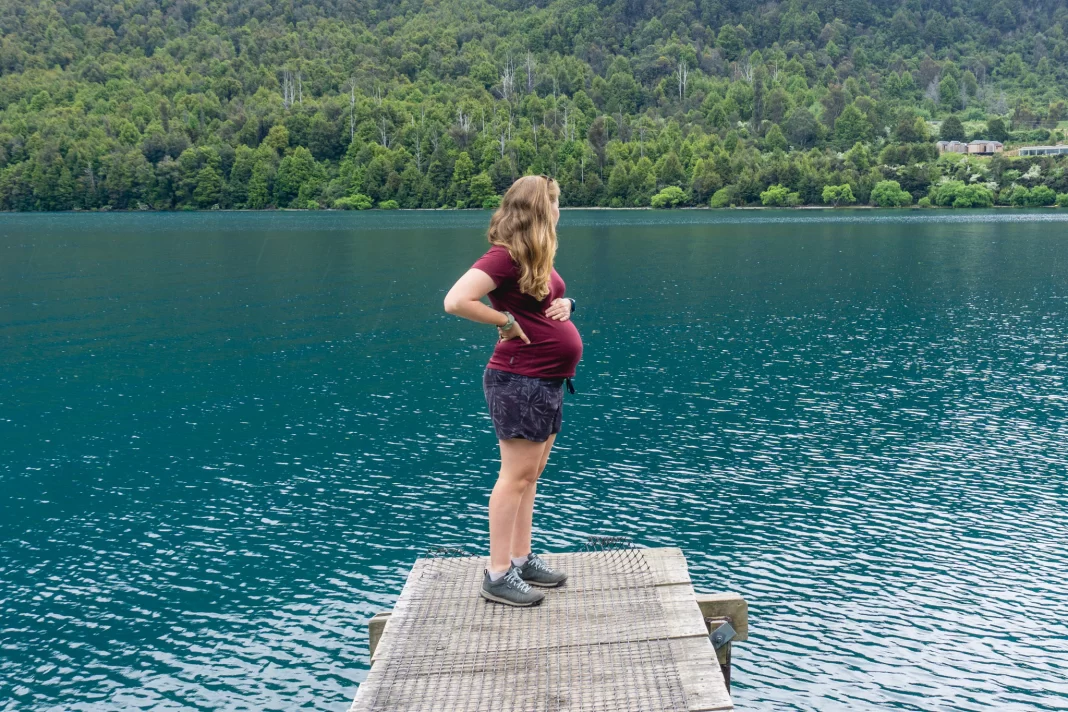
Some people also notice significant changes to their feet size during pregnancy, or that their feet or ankles swell during the day. Keep this in mind with regards to your socks and boots – if you haven’t been doing much walking with a certain pair of footwear then it would be prudent to test their fit at the end of a normal work day before heading out on the trail with them.
Centre of balance
As you belly expands, you centre of balance will also change, particularly when you add the extra weight of a pack to your back. Many pregnant people find that they prefer trips over smoother terrain during the last few months of pregnancy as their balance becomes affected. Using poles can also help, as can lessening the weight in your pack.
On top of this, your stomach will now limit your ability to see your own feet (and the ground under them), as well as affect your ability to step up and over obstacles. Off track trips will be a lot more difficult, and most people prefer to stick to easier tracks for this reason. I also find it much more difficult to get up off the ground, or anything that involves me bending down like retying boot laces, putting on socks or setting up a tent.
Core muscles
During pregnancy your core muscles stretch and expand to make room for the growing baby. This means they become less effective, and can separate (called diastasis recti). I’ve found that I have to be careful picking up weight (like my pack), and that even things like turning over in bed can feel like a marathon effort. General tasks that use the core muscles have become harder for me, and fatigue me more quickly. Having someone take over some of these tasks (like pitching the tent) is very helpful.
On top of this, from third trimester onwards it is strongly recommended that you do not lie on your back for any length of time (as this puts pressure on important blood vessels and can increase the risk of stillbirth). In conjunction with the changes to my core muscles, I found sleeping much less comfortable even at home (let alone on a thin DOC mattress). This sounds like a small complaint, but it’s made me really miserable at times, and can lead to fatigue, which in turn can make everything harder and increase your risk of injury.
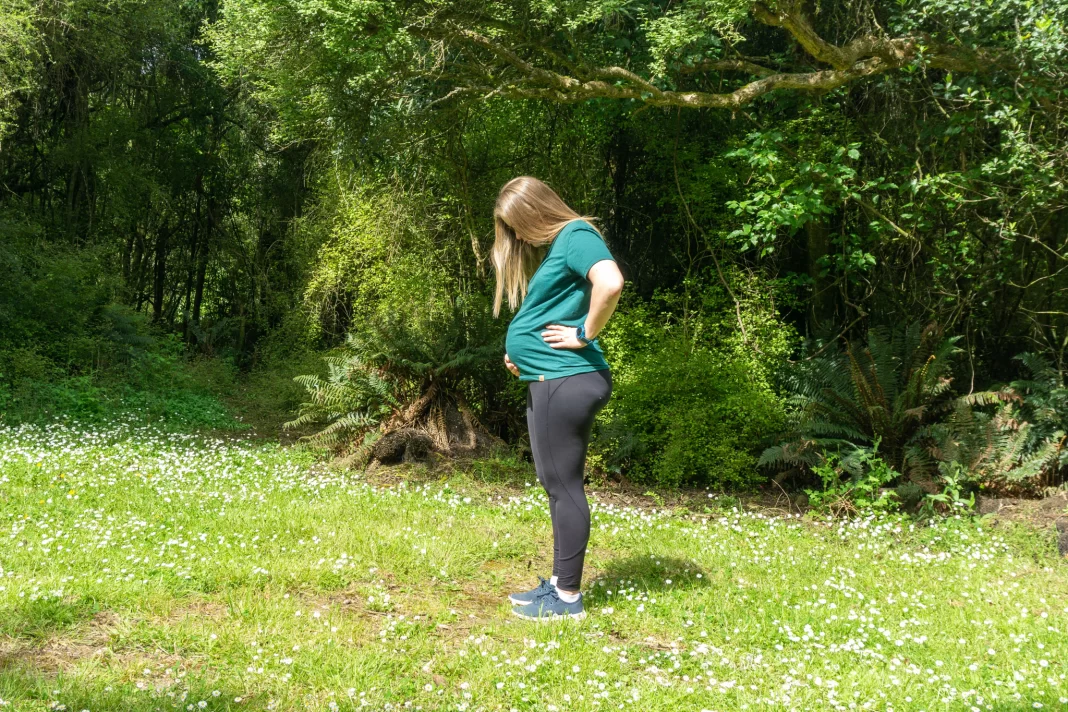
Heat
As pregnancy progresses, most people find it harder to deal with heat (even when it doesn’t seem that hot to other people). You’ve got a built-in heater in your womb, so I guess it makes sense! Be careful to keep adequate levels of hydration, and really carefully plan your trips around the weather. I was already struggling with this at 29 weeks, and have really not enjoyed humid days.
Wearing a cooling neck wrap or a bandana/buff soaked with cold water can help, as can taking frequent breaks, or choosing walks that offer shade from the sun.
Access to healthcare
As I get closer to my due date and my pregnancy gets a little more complicated due to my little babe stubbornly lying sideways in the womb, I am having to reduce how far away I am from my choice of birthing location. This is obviously a personal choice for everyone and will depend on your pregnancy, but for me it means limiting the distance from our house that we travel for trips, and choosing shorter walks that are more accessible. Your midwife will let you know their advice in terms of when to start limiting your travels.
Third trimester – summary
I still have a bit of third trimester to go, but as of 35 weeks I’ve well and truly slowed down. Tramping while pregnant has become harder and slower, and I’ve found I’ve had less energy and motivation to get out there as well. Instead my priority has shifted to logistically preparing for such a big life change (“they’ll go through how many nappies in the first 24 hours??”). From now on I’ll be sticking to just short day walks to keep my body moving.
Final thoughts on tramping while pregnant
Pregnancy is one of the craziest things your body can go through. I’ve found that continuing to tramp during my pregnancy has made me feel empowered, and helped me deal with many of the symptoms that go along with being pregnant. It wasn’t always physically easy or fun, but for me it was definitely worth it for my mental and emotional health. I hope that I’ll continue to tramp once this little babe is born – I guess we’ll see!
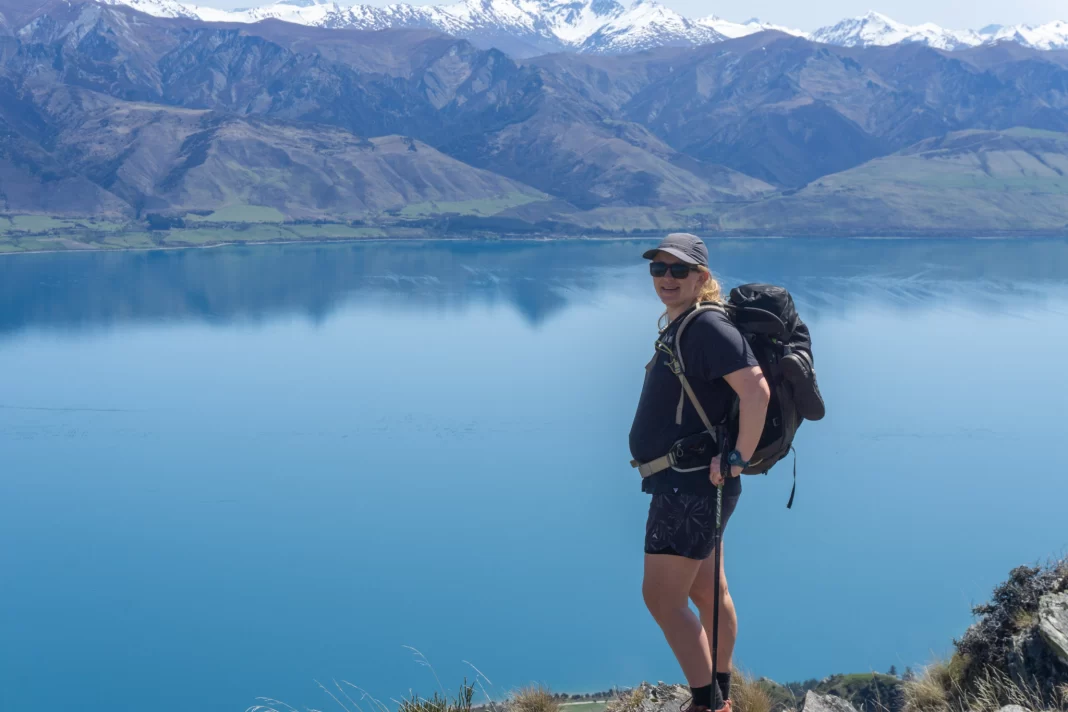
I know that for many pregnant people, being this physically active isn’t an option. I’ve been very lucky with a (up until recently) straightforward pregnancy. If you can’t (or don’t want to) go tramping or be very physically active while pregnant, that is completely valid too. Resting during this crazy time is sometimes what is needed! I’ve definitely done a lot of resting too. It’s also ok if you can’t continue exercising at the same level as you expected.
I hope this article has been helpful and informative. But remember, this is just my experience. Every pregnancy is different, so comparing yourself to others (or even to your past pregnancies) is just unfair to yourself. I didn’t publish this with the aim of setting an example to follow or glorifying pushing yourself physical while pregnant, rather just to encourage people who want to keep tramping while pregnant – your life isn’t over!
If you have any questions, comment below or message me over on Instagram. I love chatting with people about all things tramping related.
All the best!
Stay safe and keep adventuring

Hi, I’m a pregnant kiwi about to get back into tramping (second trimester) and this was such a helpful article! Thank you for writing it and taking a detailed, thoughtful and pragmatic approach. I’ll be keen to hear about your adventures with the bubba!
Aw thanks Nina, comments like these make my day <3 Congratulations on your pregnancy and best of luck getting back into it! I hope your body allows you to do some cool adventures before bubs arrives, but equally don't feel bad if it doesn't - every pregnancy is different.